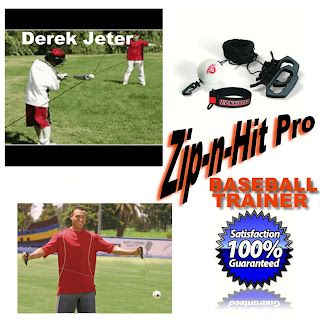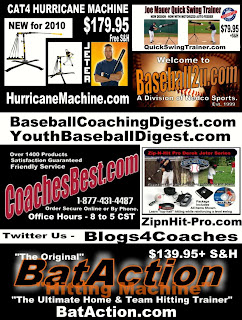
By Chip Lemin
Greetings to all coaches,
Now that the youth baseball season is in full swing, we will hopefully see the results of any pre-season work. If your team worked extra hard on defense, you should see the results. You may also notice a drop off in offensive production, due to the extra time on defense. This is normal and will adjust itself over the course of the season. What you don't want to see is any of your players coming down with sore arms as the result of too much off season throwing.
Many teams want to get started early in the year,often many weeks before the start of the season. Too often these practices include too much throwing without monitoring the amount of throws by the players. Players are also not properly warmed up,or worse yet, not stretched out enough. Often, coaches will have the players throwing too hard, too early.Coaches need to teach players how to properly stretch out and warm up early in their careers. An 8 yr old may not need to warm up as much,but they should be taught. As these players get older,it will become very important. They must have this ingrained into them before that age. This is YOUR responsibility as a youth baseball coach.
These players that came down with sore arms all had some type of growth plate injury. Their parents listened to the players complaints and went to doctors for exams.The good thing is that none of these injuries were very serious yet. They were the result of overuse. It began with too much pre season throwing.I know that none of these coaches did this out of negligence. They are all good veteran coaches from successful programs.
One parent, who is a good friend of mine, stated that the specialist they saw, told them this fact. No player at 12 years old should have ANY ARM PAIN. If they do, shut them down right away. Then consult your doctor.It is not worth the young player's health under any conditions.
There many ways to run pre season workouts without throwing the baseball so much. Speed and agility drills are one. Foot work drills are another. Fielding drills without throwing full speed is another. You want your players to come out of spring training fresh and ready to play, not compensating their throwing form because of a sore arm. Remember, these young players may not want to disappoint the coaches or parents by getting hurt,so they may not tell you. You must pay attention to your players. If you see any change in their form ask them if their arm hurts. The earlier it is noticed the quicker it can be treated. Many times all it will need is rest.
This just a reminder to keep a close eye on your young players. They are giving it all they have most of the time.You must give quality leadership and instruction as a youth baseball coach. Do your best to protect their health on and off the field. Please abide by pitch counts for your age groups. Thanks for your time and I hope you and your team are enjoying a fun season. Thanks
Coach Chip.
Chip Lemin has been a promoter of youth baseball since they started using aluminum bats. That's a long time. I have witnessed many good people get into coaching without solid coaching skills and it is not fun for them or the kids.Today's newer coaches are also being shortchanged on sportsmanship, like there is none. Visit my site to sign up for a insightful, informational, free coaching e-course at http://www.baseballecourse.com
Article Source: http://EzineArticles.com/?expert=Chip_Lemin
sponsors:
Recommended Baseball Sites:
Baseball Coaching Digest
Baseball Coaching Digest - Today's Post
Baseball Coaching Digest: Daily Post Archive
New Articles for Coaches
Baseball Coaching Articles by Coach Nick Dixon
New Baseball Blogs
Videos for Baseball Coaches
YouthBaseballDigest.com
Homepage
Today's Youth Baseball Coaching Feature Article
Videos for Coaches
Blogs & Knols for Baseball Coaches, Players & Parents
BaseballParentGuide.com
Homepage
Baseball Parent Guide: Today's Post
Baseball Articles for Coaches
Baseball Blogs
Teaching Your Child to Hit
Throwing and Pitching Fundamentals
Buying Guide For Baseball Parents
Current Topics and Issues Related to Safety in Baseball
Also:
Check out our network of baseball blogs:
Blogger (Blogspot) - baseballcoachesdigest
Blogger (Blogspot) - baseballparentguide
Blogger (Blogspot) - baseballhomeworkhelp
Blogger (Blogspot) - batactionbaseballtraining
Blogger (Blogspot) - battingcagebuyingguide
Blogger (Blogspot) - coachesbest
Blogger (Blogspot) - teeballcoachingclinic
Blogger (Blogspot) - hurricanebaseballtrainingmachine
Blogger (Blogspot) - teeballparentsguide
Blogger (Blogspot) - youthbaseballcoachingclinic
Shop CoachesBest.com for your baseball coaching needs including baseball training aids, training videos, and other coaching supplies. Check out the Derek Jeter Hurricane Hitting machine by SKLZ at HurricaneTrainer.com.
See the “Original” Rotational Hitting Machine at BatAction.com. Are you looking for the perfect trainer to teach proper timing and swing mechanics? You can stop looking and go to BatAction.com.















